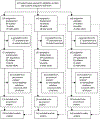Efficacy of levetiracetam, fosphenytoin, and valproate for established status epilepticus by age group (ESETT): a double-blind, responsive-adaptive, randomised controlled trial
- PMID: 32203691
- PMCID: PMC7241415
- DOI: 10.1016/S0140-6736(20)30611-5
Efficacy of levetiracetam, fosphenytoin, and valproate for established status epilepticus by age group (ESETT): a double-blind, responsive-adaptive, randomised controlled trial
Erratum in
-
Department of Error.Lancet. 2023 May 6;401(10387):1498. doi: 10.1016/S0140-6736(23)00865-6. Lancet. 2023. PMID: 37149307 No abstract available.
Abstract
Background: Benzodiazepine-refractory, or established, status epilepticus is thought to be of similar pathophysiology in children and adults, but differences in underlying aetiology and pharmacodynamics might differentially affect response to therapy. In the Established Status Epilepticus Treatment Trial (ESETT) we compared the efficacy and safety of levetiracetam, fosphenytoin, and valproate in established status epilepticus, and here we describe our results after extending enrolment in children to compare outcomes in three age groups.
Methods: In this multicentre, double-blind, response-adaptive, randomised controlled trial, we recruited patients from 58 hospital emergency departments across the USA. Patients were eligible for inclusion if they were aged 2 years or older, had been treated for a generalised convulsive seizure of longer than 5 min duration with adequate doses of benzodiazepines, and continued to have persistent or recurrent convulsions in the emergency department for at least 5 min and no more than 30 min after the last dose of benzodiazepine. Patients were randomly assigned in a response-adaptive manner, using Bayesian methods and stratified by age group (<18 years, 18-65 years, and >65 years), to levetiracetam, fosphenytoin, or valproate. All patients, investigators, study staff, and pharmacists were masked to treatment allocation. The primary outcome was absence of clinically apparent seizures with improved consciousness and without additional antiseizure medication at 1 h from start of drug infusion. The primary safety outcome was life-threatening hypotension or cardiac arrhythmia. The efficacy and safety outcomes were analysed by intention to treat. This study is registered in ClinicalTrials.gov, NCT01960075.
Findings: Between Nov 3, 2015, and Dec 29, 2018, we enrolled 478 patients and 462 unique patients were included: 225 children (aged <18 years), 186 adults (18-65 years), and 51 older adults (>65 years). 175 (38%) patients were randomly assigned to levetiracetam, 142 (31%) to fosphenyltoin, and 145 (31%) were to valproate. Baseline characteristics were balanced across treatments within age groups. The primary efficacy outcome was met in those treated with levetiracetam for 52% (95% credible interval 41-62) of children, 44% (33-55) of adults, and 37% (19-59) of older adults; with fosphenytoin in 49% (38-61) of children, 46% (34-59) of adults, and 35% (17-59) of older adults; and with valproate in 52% (41-63) of children, 46% (34-58) of adults, and 47% (25-70) of older adults. No differences were detected in efficacy or primary safety outcome by drug within each age group. With the exception of endotracheal intubation in children, secondary safety outcomes did not significantly differ by drug within each age group.
Interpretation: Children, adults, and older adults with established status epilepticus respond similarly to levetiracetam, fosphenytoin, and valproate, with treatment success in approximately half of patients. Any of the three drugs can be considered as a potential first-choice, second-line drug for benzodiazepine-refractory status epilepticus.
Funding: National Institute of Neurological Disorders and Stroke, National Institutes of Health.
Copyright © 2020 Elsevier Ltd. All rights reserved.
Conflict of interest statement
Declaration of interests
JC reports holding a patent (US9629797B2) on intravenous carbamazepine and holding intellectual property on intravenous topiramate, licensed to Ligand, on intravenous baclofen licensed to Allaysis, and on water-soluble benzodiazepine prodrugs for intranasal administration. DL reports serving on an advisory board for Bloom Science. SS reports receiving fees for serving on data and safety monitoring boards from Eisai, INSYS Therapeutics, and UCB Biosciences. HC reports receiving consulting fees from BIAL Pharma UK and Sage Therapeutics, and her institution has received funds for her work on other trials from UCB Pharma, Eisai Europe, Novartis, and GW Pharmaceuticals. NBF reports receiving grant support, paid to the University of Virginia Rectors and Visitors, from Cerebral Therapeutics, GW Pharmaceuticals, Medtronic, Neurelis, NeuroPace, SK Life Science, Takeda California, and UCB Biosciences. All other authors declare no competing interests.
Figures



Comment in
-
Second-line anticonvulsants for paediatric convulsive status epilepticus.Lancet. 2020 Apr 11;395(10231):1172-1173. doi: 10.1016/S0140-6736(20)30674-7. Epub 2020 Mar 20. Lancet. 2020. PMID: 32203690 No abstract available.
References
-
- DeLorenzo RJ, Pellock JM, Towne AR, Boggs JG. Epidemiology of status epilepticus. J Clin Neurophysiol 1995; 12: 316–25. - PubMed
-
- DeLorenzo RJ, Hauser WA, Towne AR, et al. A prospective, population-based epidemiologic study of status epilepticus in Richmond, Virginia. Neurology 1996; 46: 1029–35. - PubMed
-
- Shinnar S, Pellock JM, Moshé SL, et al. In whom does status epilepticus occur: age-related differences in children. Epilepsia 1997; 38: 907–14. - PubMed
-
- Towne AR. Epidemiology and outcomes of status epilepticus in the elderly. Int Rev Neurobiol 2007; 81: 111–27. - PubMed
-
- Betjemann JP, Lowenstein DH. Status epilepticus in adults. Lancet Neurol 2015; 14: 615–24. - PubMed
Publication types
MeSH terms
Substances
Associated data
Grants and funding
LinkOut - more resources
Full Text Sources
Medical
Research Materials
Miscellaneous

